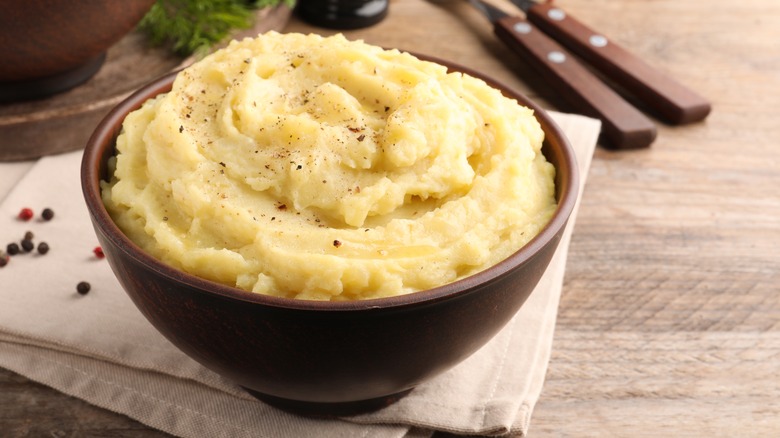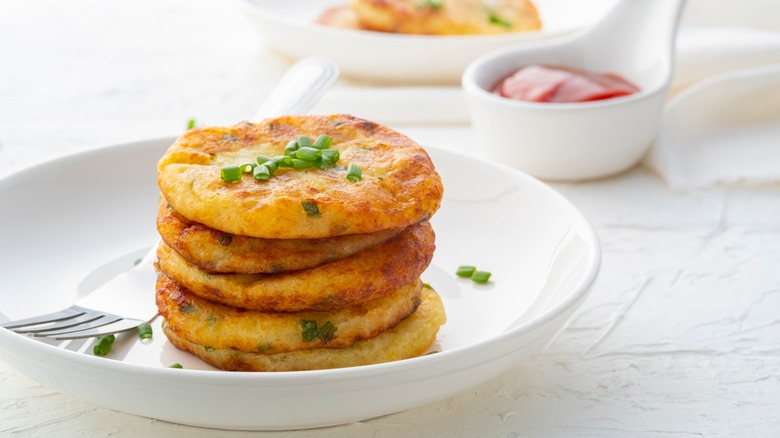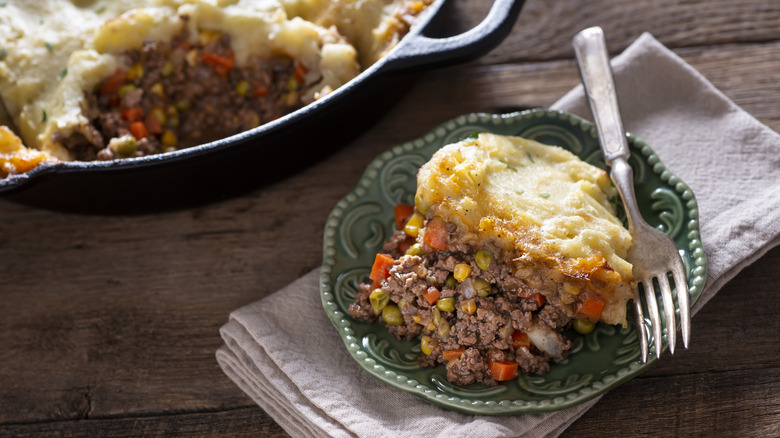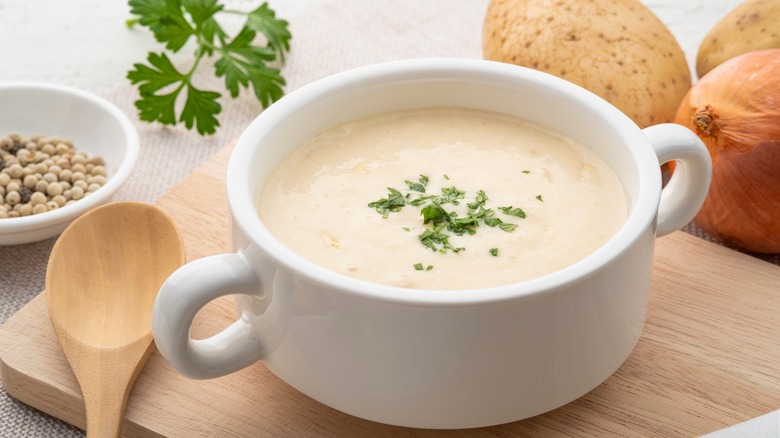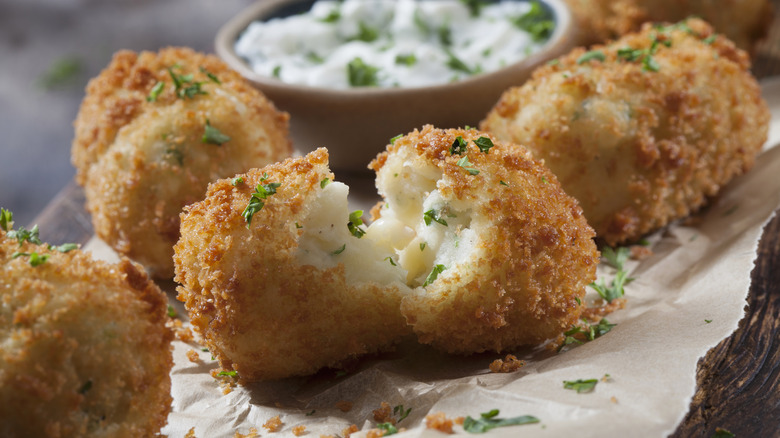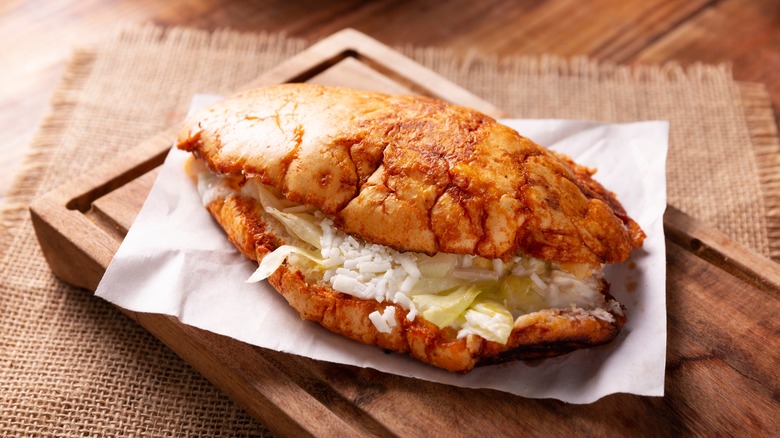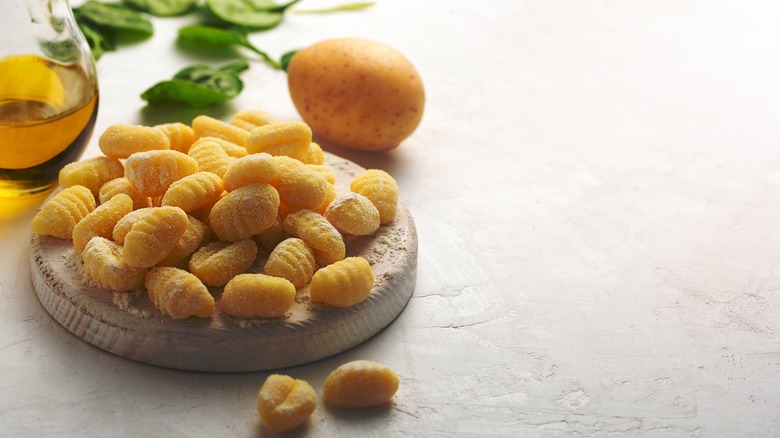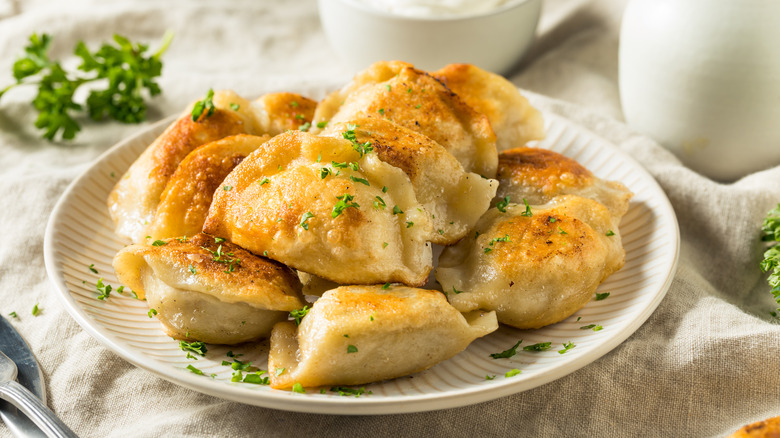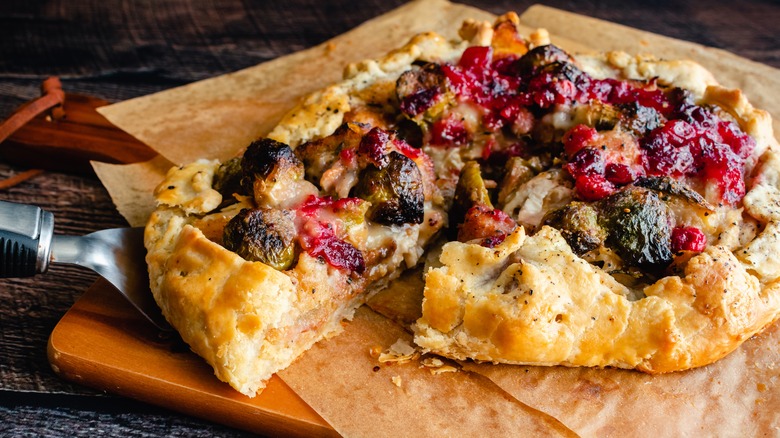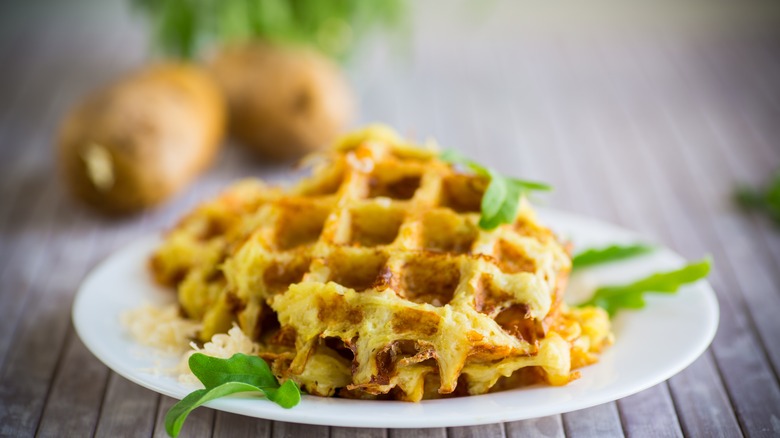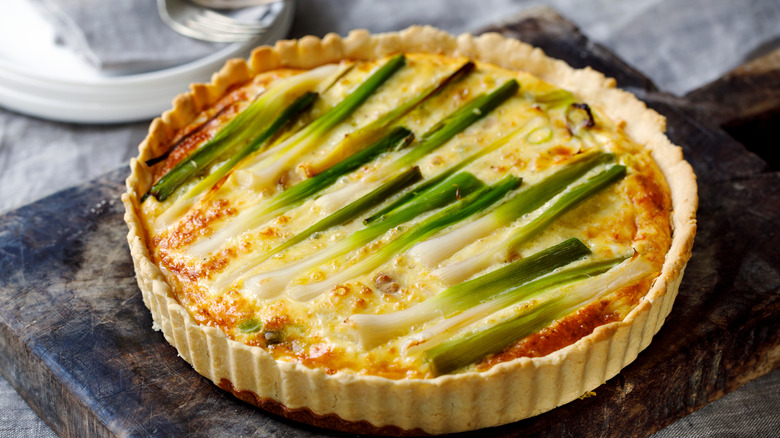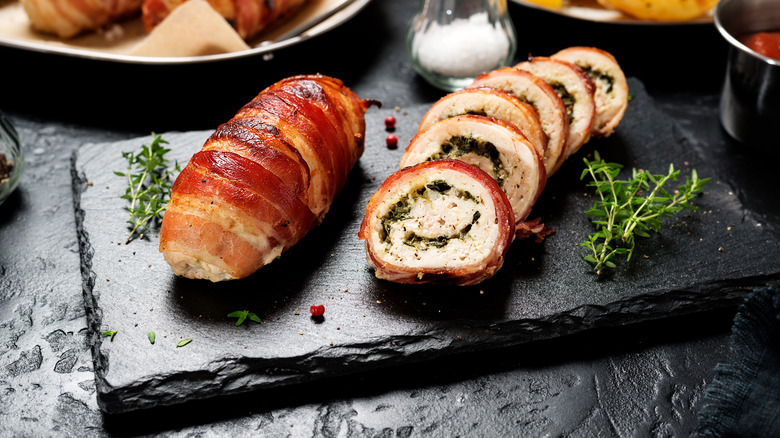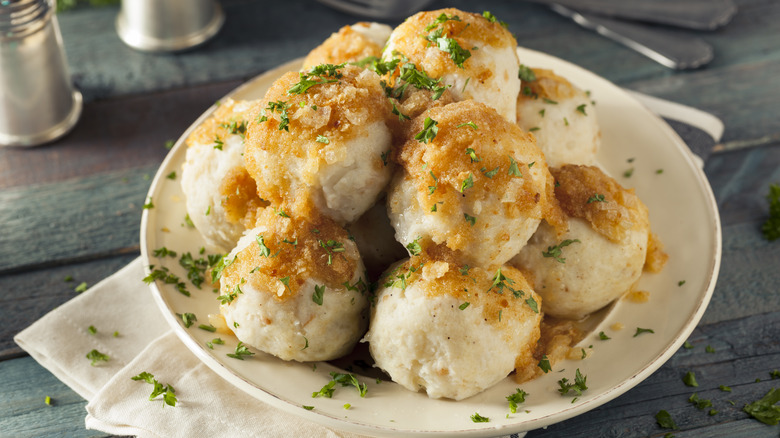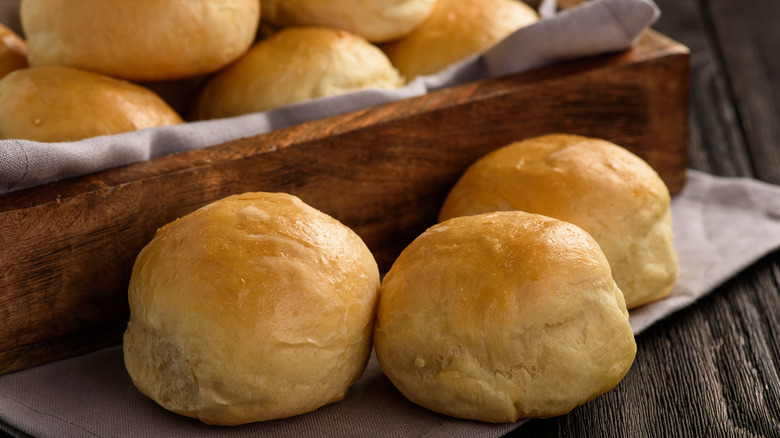13 Delicious Ways To Use Up Leftover Mashed Potatoes
If there is such a thing as a perfect vegetable, mashed potatoes would be it. This hard-working tuber can handle everything from fussy fondant potatoes to a crispy homemade chip. It's no wonder people in the U.S. love potatoes so much (The Farmer's Almanac reports that the average American eats 120 pounds of potatoes per year). Potatoes are a satisfying food with a low-calorie count. They even have protein, calcium, magnesium, and other valuable vitamins and minerals. A 1995 study published in the European Journal of Clinical Nutrition found that potatoes rank number one on the satiety index, above even cake and bread, so they are a great addition to your diet if you're counting macros.
When it comes to culinary creativity, the star of Thanksgiving side dishes, the humble mashed potato, offers a chance to expand your culinary repertoire in new directions. Sure, a simple preparation — reheated with some butter, maybe a little cream, and topped with anything from chicken nuggets to pulled pork — is always a solid choice. But if you're looking for a potato transformation that takes them from a simple side dish to the center of attention, you'll need a few more ingredients and some imagination. For a late-night snack or an elegant dinner, here are 13 delicious ways to use leftover mashed potatoes.
1. Potato pancakes (latkes)
Potato latkes are a staple holiday treat, with one major time suck in their preparation: shredding raw potatoes ahead of time and letting them drain their liquid (or squeezing it out with cheesecloth). This time-consuming step holds back potential latke makers at every time of year.
Fortunately, leftover mashed potatoes can step into the breach. This is a nice option for potato latkes that takes considerably less time. Mix mashed potatoes with beaten egg, chopped or shredded onion, and salt and pepper. The number of eggs and onions you'll use depends on your taste preference and how much mashed potato you have. Add enough beaten egg to form patties that hold together without being too dry or loose. Fry into crispy potato pancakes and serve with sour cream and applesauce.
Keep in mind that if you enjoy the crispy shreds of latke that occur when a stray bit of potato falls off the pancake, this recipe might not be for you. But if all you're looking for is a solid potato pancake with all the flavors you love, give this one a try.
2. Shepherd's pie
Shepherd's pie is a traditional British dish made with ground lamb, carrots, onions, and gravy and topped with heavenly whipped potatoes. It's hearty comfort food meant to satisfy a hunger built after a long day of tending the flock in cold, wet weather. But you don't need to invest in a dozen sheep to enjoy this delicious meal. In fact, it's made even easier when you have a bowl of leftover mashed potatoes on hand.
The best shepherd's pie recipes are adaptable to the ground meat that you have on hand. Although lamb is traditional, ground beef and even ground turkey are acceptable substitutes. Start by browning your ground beef and draining the fat before adding other ingredients. Carrots, peas, thyme, beef or chicken stock, and tomato paste create a beautiful filling with a rich gravy. Pour this mixture into a baking dish.
If your leftover mashed potatoes are dry, loosen them up by adding butter, heavy cream, or milk. Spoon the mashed potatoes directly on top of the filling or scoop them into a piping bag fitted with a larger star tip and get fancy with your piping skills. Regardless of how you do it, you want at least an inch of potato on the top of your filling. Bake until the top is golden brown, and let it sit for 10 minutes before serving.
3. Cream of potato soup
Substantial soups are the ultimate cold-weather comfort, and few soups are more satisfying than a bowl of creamy potato. If you have leftover mashed potatoes, it's easy to transform pantry staples into a dreamy supper. You can thin the potatoes with a little stock and milk, warming and serving, or take the time to build flavor with a few extra steps.
Start by browning diced onion in butter or olive oil (or a mix of both). Add salt and pepper as you brown the onion, but proceed with caution. Your mashed potatoes may also have seasoning on them. Although potatoes can absorb a lot of salt, you don't want to go overboard initially. You can also add diced carrot and celery to the onion for a more complex flavor, and dried herbs like thyme and tarragon should be added at this stage, too.
When your onions are translucent, add mashed potatoes and thin with the broth or stock of your choice. Vegetable broth works just as well as chicken or beef. Cook until the soup is warm, and consider adding a splash of heavy cream before serving. If you prefer, use an immersion blender to purée the soup further or serve it as is. Serve with crumbled bacon, shredded cheddar cheese, and chopped chives.
4. Potato croquettes
Some people mistake potato latkes for potato croquettes. The difference is in the breading: Potato latkes are shallow-fried without breading, while potato croquettes are breaded and either shallow- or deep-fried. Both can be made with leftover mashed potatoes.
Leftover mashed potatoes aren't the only thing you can put in a potato croquette. There are many different flavor combinations and additions, making them perfect for cleaning out the fridge. Add some leftover chopped chicken or ground beef, or throw in the mixed vegetables from a previous dinner. You can even add cheese of any type — think mozzarella for that stretchy, Instagram-worthy cheese pull or grated Parmesan for a salty touch. If your mashed potatoes are dry, add an egg as a binder to help them stay together. Roll the potatoes into a ball and then roll the ball into bread crumbs. Use your deep fryer if you have one, or fry in neutral oil heated to 350 degrees Fahrenheit until the outside is crispy and golden. Remove croquettes from the pan with a slotted spoon or a spider, and season them while they drain on paper towels.
5. Pambazos
Many people are familiar with Mexican food primarily in the form of tacos, burritos, and the occasional chimichanga. They may have no idea that potatoes are an integral part of Mexican cuisine. Along with Spanish explorers in the 16th century, potato cultivars traveled from South America, where potatoes are a staple food of the Andean people. They quickly became integrated into the cuisine of Mexico and are popular in all types of dining there.
These days, small, thin-skinned potatoes are most frequently used in Mexican cuisine, and nowhere are these beauties more delicious (arguably) than in pambazos — Mexican street food at its finest. Pambazos have a filling made of chorizo and potatoes ladled onto pan basso, a chewy white bread that holds its texture as it soaks in a bowl of guajillo salsa. That's right: This sandwich is filled and rests on bread that has been marinated in a spicy, tangy sauce.
To make pambazos at home with leftover mashed potatoes, cooked crumbled chorizo with potatoes and onions. If you cannot find pan basso, look for soft bread with a tough exterior. Slice the bread, dunk it in guajillo salsa, and lightly fry it before stuffing it with chorizo and potato. Serve with pickled onions, queso fresco, shredded lettuce, plenty of napkins, and an ice-cold cerveza.
6. Potato gnocchi
Gnocchi is rustic food, but for some strange reason, this pillowy puff of potato pasta is intimidating to cook at home, often turning out gummy and dense. It's typically made with a baked potato that is then split and cooled, which allows the flesh to dry, resulting in puffier pasta. But a more convenient take on this dish is to use leftover mashed potato, skipping the extra baking step and producing a gnocchi that any Nona would be proud of.
To make gnocchi at home, you'll need flour, leftover mashed potatoes, and a beaten egg (or two, depending on how much you make). Gnocchi is a great place to use gluten-free flour blends, as the lack of gluten can make a more tender pasta. Gently mix the flour, leftover mashed potatoes, and beaten egg. Knead it gently until it comes together; a good test of the proper texture is squeezing your earlobe — that's essentially the density you want. Roll your gnocchi into ropes and cut into 1-inch pieces. You can cook them like seamless poufs or roll them across the tines of a fork to make slight indentations before cooking.
To cook, drop gnocchi into salted boiling water and remove when they rise to the top. Add to a pan of heated butter and brown, then serve with plenty of Parmesan. You can also skip the sautéeing and make crispy baked gnocchi after boiling.
7. Potato and cheese pierogi
Pierogis are the perfect combination of cheese, potato, and pasta. Pierogi means "dumpling" in Polish, and both dishes share similarities in how they are stuffed and cooked. Think of them as Eastern European ravioli: delicate pasta surrounds a filling traditionally made of potato and onion (but can include any kind of cheese, plus beef and sometimes veggies).
You're halfway to a delicious potato and cheese pierogi if you have leftover mashed potatoes. You can make your own pierogi dough; traditional pierogi dough uses a hot water crust method, which adds hot water to butter and flour, with some cooks including an egg. Knead until the dough comes together, and then let it rest. You can also purchase wonton or dumpling wrappers if you don't feel like making your own dough.
When your dough is ready, cut it into circles (or keep it in squares if you buy wrappers). Place a heaping teaspoon of filling on one half of the dough and fold the other half over. Press the edge firmly to seal, then drop the sealed pierogies into salted boiling water, removing them as they float to the surface. You can then sautée the pierogies in a bit of butter. Serve with traditional accompaniments such as sour cream, chives, and fried onion.
8. Potato galette
Pie crust is another thing that many home cooks and bakers shy away from. It seems fussy, and it is hard to make a professional-looking finish. If this sounds like you, a galette is the answer to all of your pastry problems. This free-form pastry crust is folded around sweet or savory fillings and baked. Not only is it more forgiving and rustic, but it's also the ideal way to use up Thanksgiving leftovers.
Use any sugar-free pie crust recipe you like, or purchase premade rolled dough. If you opt for premade dough, go over it once or twice with a rolling pin to ease out creases. For a slightly elevated option, you can also make a defrosted puff pastry galette.
When you make your filling, remember that you want to remove excess water before you bake. Mashed potatoes are a great base layer, as they will absorb any moisture from fresh vegetables or other filling. For a Thanksgiving galette, spread mashed potatoes in a circle on the pastry, then top with other leftovers, including Brussels sprouts, stuffing, chopped turkey, and even green bean casserole. Fold the edges of the pastry over to create a border around the filling, then brush with an egg wash (beaten egg with a little water to promote browning). Bake until the pastry is golden brown. Serve with cranberry sauce on the side.
9. Potato and cheddar waffles
In the waffles vs pancakes debate, potato and cheddar waffles tip the scales inexorably in the direction of the crevices and crunchy pinnacles of the waffle. Even better? Using leftover mashed potatoes to whip up this salty, crunchy, and infinitely satisfying late-night snack.
You'll need a heated waffle iron, grated cheddar cheese (or any cheese you like), and a little milk (or stock if you don't want to add more dairy). Mix mashed potatoes and cheddar cheese, then gradually add milk or stock until you reach a consistency that is somewhere between paste and thick apple sauce. It should not be liquid, but it should be able to spread across the waffle iron (even if it needs some encouragement).
Cook until the exterior is crispy (times may vary), and treat it like a baked potato. Serve with sour cream and chopped bacon, or toss a piece of fried chicken on top and drizzle it with hot honey. Eat standing over the kitchen sink.
10. Potato and leek quiche
Quiche is the star of many a Sunday brunch and with good reason: It's a largely hands-off dish that serves many different people, and it's a good place to use up leftovers that might otherwise not be eaten. Potato and leek quiche is a French classic, updated to include leftover mash. Start with homemade pie crust, or purchase a premade pie crust in a disposable aluminum tin. You'll need to blind-bake the crust, as quiche is a custard-based dish with a long cooking time. Blind baking prevents the dreaded soggy bottom from occurring.
While the crust is blind baking, sautée leeks, then add your leftover mashed potatoes, beaten eggs, and cream. The ratios will change depending on the size of your pie crust. In general, add a half-cup of dairy for every large egg. You may need more liquid to accommodate the dryness of the mashed potatoes. Pour the filling into the blind-baked pie crust and bake on a baking sheet until the quiche is nearly set (look for a slight wobble). Remove from the oven and let it sit for at least 15 minutes (longer is better).
11. Potato and spinach stuffed chicken
Stuffed chicken breast is an elegant dish that's also homey and rustic — perfect for when you'd like something special but don't want to fuss too much. Leftover mashed potato, cooked spinach, and cheese is a perfect combination.
You have two options when it comes to stuffing the chicken breast. The easiest is to slice the breast into two thin layers, leaving one side partially connected, before filling and baking or pan-frying. The other option is to make a roulade. A roulade is essentially a rolled presentation sliced before serving to show off the beautiful spiral you've created. To make a roulade, sandwich your chicken breast between two layers of plastic wrap (or slide it into a zip-top plastic bag) and use the flat side of a meat tenderizer to pound it thin.
Mix mashed potatoes; cheese; and defrosted, drained spinach together (you may need to add a little milk or cream to get it loose), then spread in an even layer across the chicken breast. Roll the breast tightly, then secure with cooking twine to bake or pan-fry. Slice before serving to highlight the interior spiral. If you pan-fry, use stock or white wine to deglaze the pan and make a simple pan sauce for serving.
12. Potato dumplings (kartoffelknödel)
Traditional German potato dumplings are served with braised meats and cabbages, making them perfect for cold weather. Even better, they are prepared using cooked potato and other simple pantry ingredients that come together in no time. This makes them an exceptional last-minute dinner when you need something filling but lack time or energy for cooking.
Bring a large pot of salted water to boil. While it's heating up, mix your dumpling dough. Combine beaten egg, mashed potatoes, and a starch of some kind (potato starch, cornstarch, or flour). The egg and the starch act as a binding agent to keep your dumplings together. You can also add other ingredients like ham or sauerkraut. Don't forget to season your dumplings with salt and pepper, too.
Form into two-inch balls and drop them into the boiling water. When they float to the top, turn the heat to a simmer and cover the pot. Cook your dumplings for another 20 minutes, then drain and serve with buttered bread crumbs, black pepper, and chopped fresh parsley.
13. Potato bread (kartoffelbröt)
Leftover mashed potatoes make another traditional German staple: potato bread. Potato bread and potato rolls are fluffy, spongy bread with a quick rise time. This makes them a fast solution when you need delicious bread quickly.
The most straightforward version of potato bread uses just mashed potatoes, yeast, bread flour, and some type of fat. You may not need too much fat, depending on how much is in your mashed potatoes. Simply knead these ingredients together and allow them to rise in a warm place in your kitchen before baking off a quick loaf (or dividing it and baking rolls).
Use potato bread as an accompaniment to soups and stews or as the base for a sandwich. Potato bread goes with any meal of the day — even dessert. If your potato bread becomes stale, slice it, douse it in custard, and bake it off for a flavorful bread pudding.

